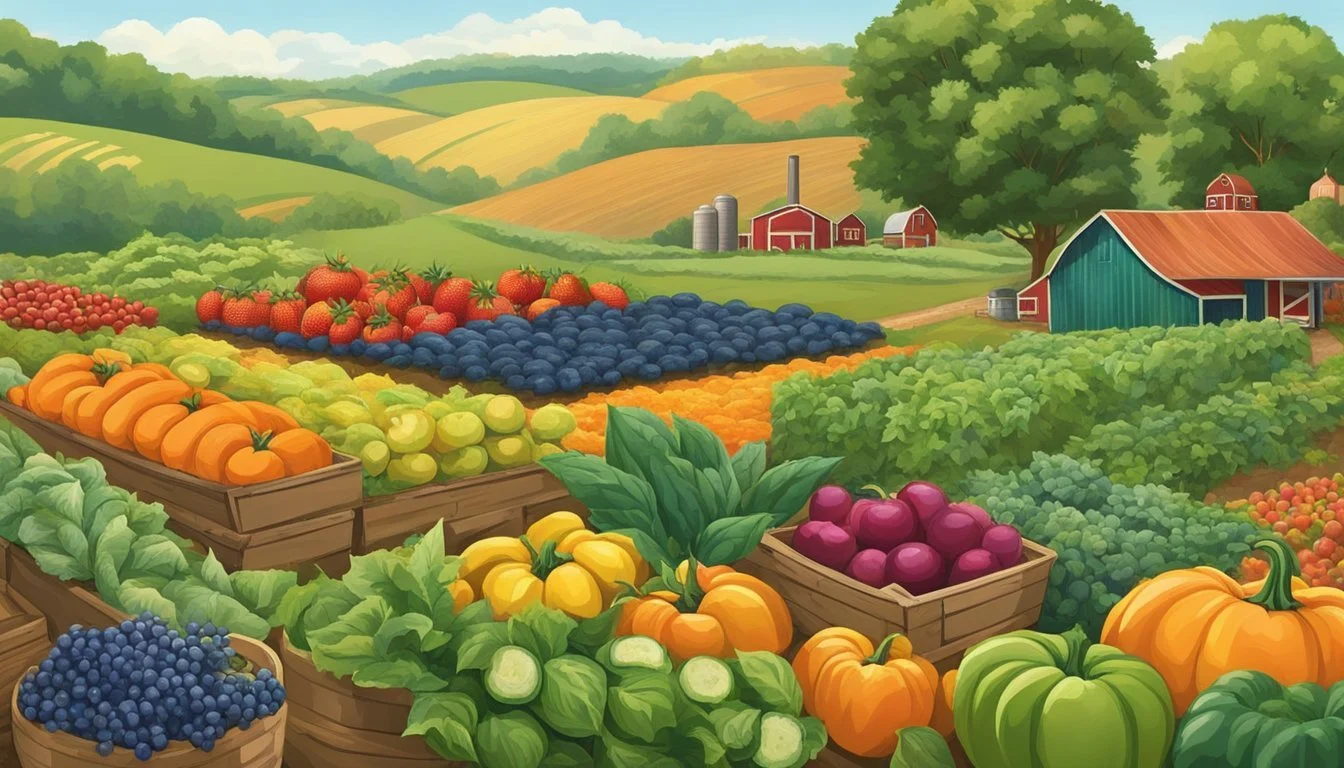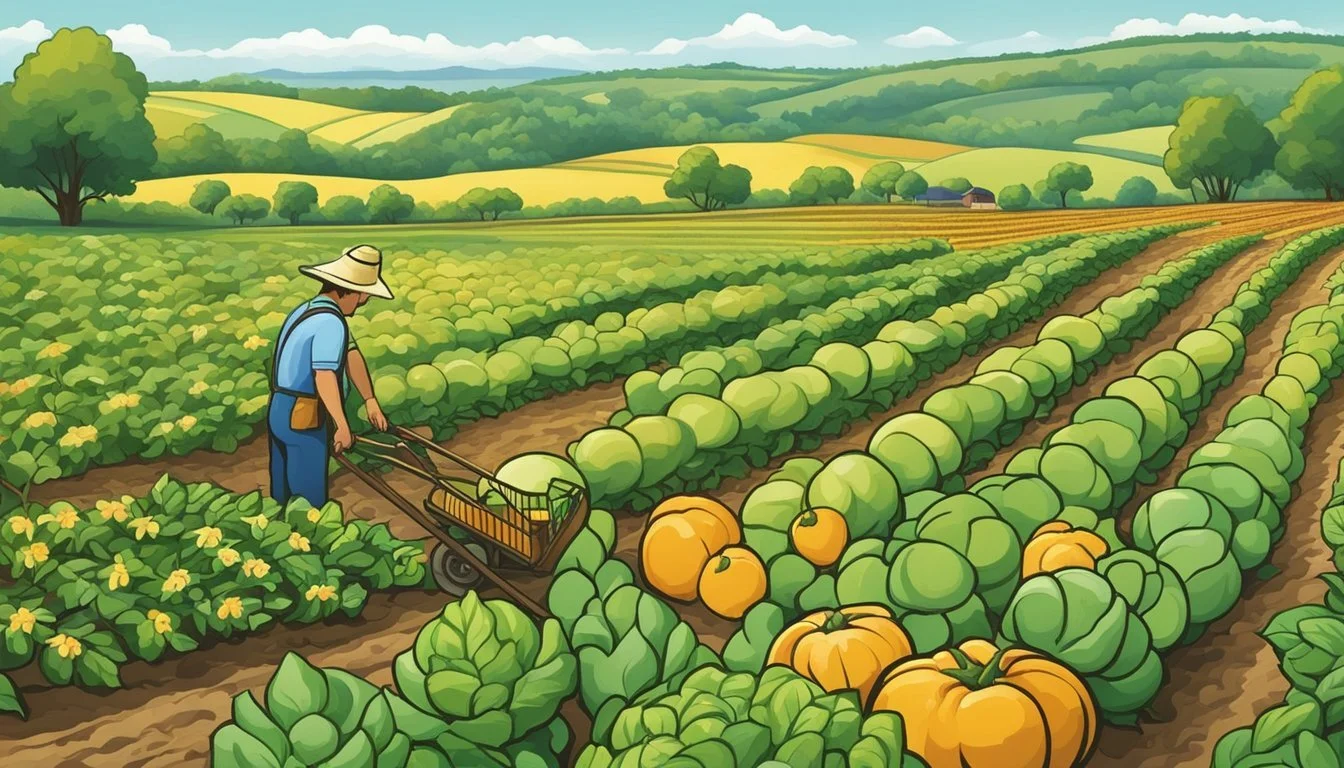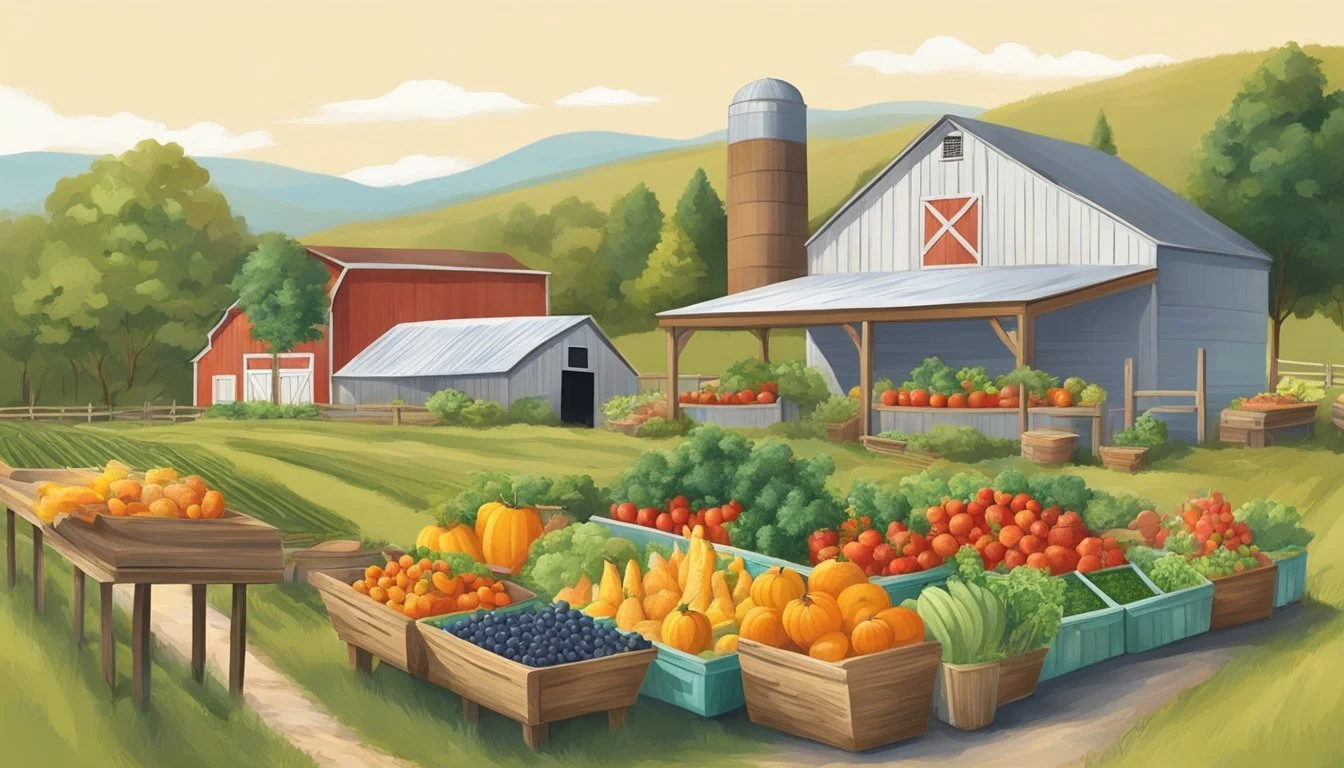Tennessee Seasonal Fruit & Veg Guide
Your Year-Round Companion
Tennessee's varied climate and soils allow for a rich diversity of fruits and vegetables to be grown and harvested throughout the year. Understanding when each type of produce is at its peak can greatly enhance the freshness and flavor of meals while supporting local farmers and the economy. Seasonal eating in Tennessee means enjoying strawberries and leafy greens in the spring, juicy tomatoes and sweet corn in the summer, crisp apples and root vegetables in the fall, and hearty squashes in the winter.
Adhering to a farm-to-table approach not only ensures the consumption of nutrient-rich food but also reduces the carbon footprint associated with long-distance food transport. For the residents of Tennessee, this guide serves as a tool to navigate the seasonal availability of local produce, allowing them to plan meals around the freshest ingredients and to patronize community-supported agriculture (CSAs), farmers' markets, and local grocers.
The state's produce calendar is influenced by local weather patterns and may vary from year to year. This emphasizes the importance of being mindful of regional growing seasons and staying informed through local agricultural resources. By doing so, consumers can make educated choices about the fruits and vegetables they purchase and enjoy, while celebrating Tennessee's bountiful harvests.
What’s in Season in Tennessee Right Now?
Seasonal Overview of Tennessee Produce
Tennessee's varied climate with its four distinct seasons affords a wide array of fruits and vegetables throughout the year. The growing season typically begins in the spring and extends into late fall, offering fresh produce directly from family farms.
Spring Harvest
During spring, Tennessee weather warms, welcoming a range of produce. Strawberries and asparagus emerge as early favorites, often ready by May. Lettuce and kale also thrive in the mild spring climate, making them staples in early farm-to-table selections.
Summer Abundance
As the summer heat intensifies, so does the variety and volume of available produce. Tomatoes, corn, and blueberries hit their peak between June and August. Peppers and various types of squash also become readily available, harnessing the full swing of the summer harvest.
Fall Harvest
Fall in Tennessee brings a shift in the palate of produce. This season is known for its apples and pumpkins, perfect for autumnal recipes. The harvest continues with sweet potatoes (What wine goes well with sweet potatoes?) and pears, which usually reach their peak in late September and October, nourished by the cooling weather.
Winter Selections
Winter's chill limits the variety of produce but does not halt it. Hardy vegetables such as turnips and cabbage withstand the cold. A selection of greens, including collards and mustards, are typical winter crops that can endure frost, providing fresh greens even in the coldest months.
Featured Tennessee Fruits
Tennessee offers a diverse array of fruits throughout the year, each prized for their distinctive flavors and varieties. This guide takes you through the main categories of berries, stone fruits, and orchard fruits that are locally grown and seasonally available in the state.
Berries
Blueberries: Found fresh in Tennessee from June to July, they vary from sweet to mildly tart.
Blackberries: (how long do blackberries last?) Available from June to August, they are known for their juicy and sweet flavor with a hint of tartness.
Strawberries: Harvested from April to June, these berries are sweet and fragrant.
Raspberries: With a summer-bearing season, raspberries offer a subtle sweetness followed by a tangy flavor.
Stone Fruits
Peaches: Juicy and aromatic, peaches are ripe for picking from June to August.
Nectarines: Similar to peaches but with smooth skin, they peak in the same season and deliver a slightly more intense flavor.
Cherries (how long do cherries last?): Cherries boast a short season, usually from June to early July, presenting a sweet to tart taste.
Plums: Available from June to early October, plums offer a sweet taste with a slight acidic edge.
Orchard Fruits
Apples: With varieties that range from tart to sweet, Tennessee apples are typically harvested from August to November.
Pears: Harvested from August to October, pears come in varieties that offer a range of flavors from buttery to sweet and slightly tart.
Featured Tennessee Vegetables
Tennessee's varied climate allows for a diverse array of vegetables to flourish throughout the year. This section spotlights the root vegetables, leafy greens, and the nightshades and cucurbits that are integral to the local farm-to-table movement.
Root Vegetables
Root vegetables in Tennessee are prized for their earthy flavors and nutritional content.
Carrots: Various varieties, such as 'Nantes' and 'Danvers', are cultivated for their sweet, crisp taste.
Beets: Both red and golden beets with their deep, earthy sweetness are common.
Sweet Potatoes: Coveted for their creamy texture and sugary flavor.
Turnips: Often white and purple in color, they offer a peppery bite that is milder when cooked.
Leafy Greens
Leafy greens, essential for their nutrients and versatile use in the kitchen, grow well in Tennessee's soil.
Lettuce: Includes crisphead, romaine, and leaf varieties, each with a unique texture and taste.
Kale: Known for its hearty leaves and slightly bitter flavor that softens when cooked.
Cabbage: It can range from savory to slightly sweet, and includes green, red, and savoy types.
Greens: This category often encompasses collards and mustard greens that are staples in Southern cuisine for their pungent flavors.
Nightshades and Cucurbits
This group showcases vegetables that thrive in warmer seasons with a bounty of flavors.
Tomatoes: They range from the larger, juicy beefsteak to the small, sweet cherry tomatoes.
Peppers: Varieties include bell peppers that are sweet and mild, to jalapeños that add a spicy kick.
Eggplant (What wine goes well with eggplant?): Often has a meaty texture, with varieties such as the large 'Black Beauty' or the slender 'Japanese' eggplant.
Cucumbers: Crisp and refreshing, suitable for salads and pickling.
Squash: Encompasses both summer squash, like zucchini and yellow squash, and winter varieties, such as butternut and acorn, each with its own distinct flavor profile.
Harvesting and Availability
In Tennessee, the harvesting and availability of fruits and vegetables are aligned with the growing seasons, ensuring consumers can enjoy fresh, in-season produce. Throughout the state, numerous farms offer a variety of seasonal pick-your-own experiences, while local markets stock the freshest picks in line with the harvest calendar.
Harvest Calendar
Fruits
Month Fruits Available January --- February --- March --- April Strawberries May Strawberries, Blackberries June Peaches, Blueberries July Peaches, Blueberries August Apples, Raspberries September Apples, Raspberries October Pumpkins, Apples November Pumpkins December ---
Vegetables
Month Vegetables Available January --- February --- March Lettuce, Carrots April Lettuce, Carrots, Kale May Asparagus, Broccoli June Cabbage, Cauliflower July Cabbage, Collard Greens August Sweet Corn, Tomatoes September Spinach, Turnips October Squash, Sweet Potatoes November Kale, Spinach December ---
Pick Your Own Farms
Tennessee's pick-your-own farms are scattered throughout the state, offering a hands-on approach to selecting the freshest seasonal produce. Many farms provide a map or guide to help visitors find the ripest fruits and vegetables available for harvest during the growing season. Visitors should confirm the availability before heading out, as the harvest can vary based on location and weather conditions.
Market Availability
Local farm markets mirror the harvest calendar, with availability fluctuating according to what's in season. Most markets have a direct relationship with local farms, ensuring that the produce on offer is freshly picked. The variety of available fruits and vegetables at these markets represents the diversity of crops harvested in Tennessee's different growing seasons.
Storing and Preserving Fresh Produce
Proper storage and preservation are critical for extending the shelf-life of Tennessee's abundant fruits and vegetables. This ensures a continuous supply of fresh, local produce from farm to table throughout the differing seasons.
Short-Term Storage Tips
For short-term storage, most fresh fruits and vegetables keep best when stored in a cooler environment away from direct sunlight. Items like tomatoes, squash, and cucumbers prefer a cool, not cold, environment ideally between 50-70°F. A common method involves utilizing cooling storage techniques, which include:
Root vegetables: Store in a cool, dry place; they can be kept in perforated plastic bags to retain moisture.
Leafy greens: Refrigerate in a crisper drawer with a damp cloth to maintain humidity.
Berries and soft fruits: Keep refrigerated; wash only just before use to prevent mold.
Using coolers or the refrigerator crisper can greatly increase the availability of fresh produce in the short term.
Long-Term Preservation
When considering long-term preservation, one must choose a method that best suits the type of produce and the intended use. The key techniques are:
Freezing: Fruits and vegetables retain their taste and nutritional value well when frozen. Blanch vegetables before freezing to preserve color, texture, and flavor.
Canning: Tomatoes, cucumbers, and beans are excellent candidates for canning, ensuring one has access to fresh-tasting produce long after the harvest season has passed.
Freezing charts and guidelines provide specific instructions for different produce types, while canning requires meticulous attention to sterilization and sealing to prevent foodborne illnesses. Both methods can significantly extend produce availability well into the off-season months.
Extending the Growing Season
In Tennessee, gardeners have the advantage of a long growing season, which can be further extended with careful planning and methods. Extension publications provide valuable resources that guide gardeners in adopting season extension techniques suited for different weather conditions and crop types.
Cold Frames and Row Covers: These structures help moderate temperature, protecting plants from frost and extending the harvest time for cool-season crops. Home gardens benefit from such installations by gaining additional weeks of productivity, especially in spring and fall.
Proper Selection of Site and Species: Choosing a garden site with optimal sunlight and drainage and selecting plant varieties known for their hardiness contributes to a longer growing season. Gardeners should consider both the location and the specific weather patterns of their region.
Timing of Planting: Gardeners can maximize their growing season by timing their planting carefully. Succession planting and staggered planting dates ensure a continuous harvest.
Techniques Benefits Considerations Cold Frames Frost protection Ventilation to prevent overheating Row Covers Pest barrier, warmth Light permeability Succession Planting Continuous harvest Timing for maturity Staggered Planting Spread out harvest, manage workload Crop selection and space
Using a combination of these strategies, Tennessee gardeners can achieve an effective extension of the growing season in their home gardens, leading to an extended period of fresh produce, optimal use of space, and potentially higher yields.
Sustainable Farming Practices
Tennessee farms are increasingly adopting sustainable farming practices to promote environmental health and food quality. These practices focus on maintaining soil integrity, conserving water, and enhancing biodiversity.
Crop Rotation and Diversity: Farms implement crop rotation to prevent soil depletion, reduce pests, and break disease cycles. Diverse crop selections support a balanced ecosystem and contribute to soil health.
Soil Management: The application of organic matter, such as compost, enhances soil fertility and structure. Cover crops are also utilized to protect soil from erosion and to fix nitrogen in the soil, reducing the need for chemical fertilizers.
Integrated Pest Management (IPM): This method uses a combination of practices to manage pests with minimal impact on the environment. Techniques include the introduction of beneficial insects and selective use of pesticides.
Water Conservation: Farms employ drip irrigation systems to optimize water use and prevent water waste. Rainwater harvesting and the use of mulches to retain soil moisture are additional measures taken.
Renewable Energy: The use of renewable energy sources, such as solar or wind power, reduces the carbon footprint of farming operations.
Sustainable Livestock Management: Farms that raise livestock do so with a focus on well-being and land management, including rotational grazing systems that improve pasture conditions and animal health.
Tennessee's sustainable farms play a critical role in ensuring a resilient food system through their commitment to these environmentally conscious practices.
Farm to Table Recipes
Tennessee's bountiful harvest offers a plethora of favorite fruits and vegetables that inspire an array of farm to table recipes. Seasonal produce brings not only fresh flavors but also the joy of cooking with ingredients at their peak.
One can begin by appreciating the versatility of apples, which transition smoothly from sweet to savory dishes. A crisp apple can be the star in a salad, paired with robust cheeses and mixed greens, or transformed into a heartwarming apple cobbler that embodies the essence of fall.
Sweet potatoes are another staple of the Tennessee autumnal table. Their natural sweetness is enhanced when roasted, making them the perfect side dish, or when mashed, they provide a creamy base for hearty soups.
Here are some applications for these season's offerings:
Fruits:
Apples: Pies, crisps, salads.
Pears: Tarts, poached pears, chutneys.
Berries: Cobblers, jams, fresh in salads.
Vegetables:
Sweet Potatoes: Soups, casseroles, baked.
Pumpkins: Pies, roasted pumpkin seeds (how long do pumpkin seeds last?), ravioli filling.
The flavors of these fruits and vegetables are robust and distinct; apples and pears carry a sweet-tart profile perfect for desserts and salads, while sweet potatoes and pumpkins deliver a comforting earthiness to any dish.
Recipes should embrace the natural simplicity of these ingredients, allowing their flavors to shine through. One could opt for a pumpkin soup garnished with a hint of cinnamon or a blackberry jam that captures the essence of summer.
These farm to table recipes are more than just meals; they are a celebration of Tennessee's rich agricultural tapestry and a testament to the state's seasons guiding the way we cook and eat.
Supporting Local Agriculture
Tennessee boasts a rich agricultural landscape with a variety of local farms playing a critical role in the state's economy. Local farms supply fresh fruits, vegetables, and other products directly to consumers through various channels such as farmers' markets, Community Supported Agriculture (CSA) programs, and on-site farm stores.
One can access Tennessee's diverse agricultural offerings through platforms like Pick Tennessee Products which helps consumers locate farmers' markets and connect with local farmers. This initiative benefits consumers with fresh, seasonal produce and sustains the agricultural community by keeping the supply chain local.
Extension publications are a valuable resource for both growers and consumers in Tennessee. These publications provide region-specific gardening guides, like the "Tennessee Home Fruit and Vegetable Garden" PDF, which can educate consumers on when and where to find seasonal crops.
Locations across Tennessee see a range in growing season lengths. For instance, Maynardville's Seven Springs Farm to Table not only practices sustainable farming but also involves the community directly through its CSA program, emphasizing the importance of knowing where food comes from.
Consumers in Tennessee supporting local agriculture not only boosts the local economy but also contributes to a decreased carbon footprint from reduced transportation of goods. They have the added benefit of enjoying produce that is fresher and more nutritious due to the shortened time between harvest and consumption.
By choosing to buy from local farms, Tennesseans help ensure the continuation of the state’s farming heritage and reinforce a healthier, more resilient food system.











